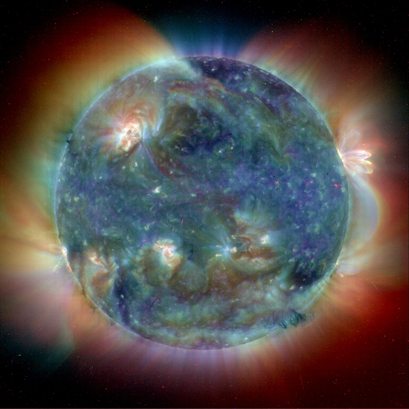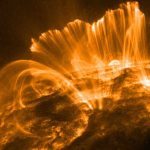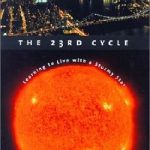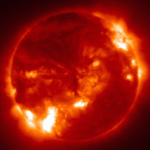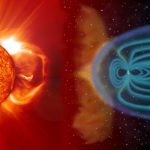“…No master mariner dares to use it least he should be suspected of being a magician; nor would the sailors venture to go to sea under the command of a man using an instrument which so much appeared to be under the influence of the powers below.” Guiot of Provins ca 1205 A.D.
The Exxon Valdez left harbor on March 23, 1989, and within hours unleashed an ecological catastrophe as it ran aground on Bligh Reef; 12:04 AM on March 24. The spilling of 11 million gallons of oil triggered a $5.3 billion lawsuit in a highly publicized court case. A decade later, the damage to the Prince Williams Sound is still evident if you literally scratch the surface of the ecosystem. The investigation focussed on the circumstances leading up to the grounding, the absence of the Captain from the Bridge, and the failure of the Third Mate to follow a proper course, but there may have been other factors at work as well.
The powerful geomagnetic storm that triggered the Ontario Blackout on March 13 was not the only event that rocked the magnetosphere that month. Ten days later, a secondary storm began 14 hours before the Exxon Valdez ran aground. The IMP-8 research satellite recorded a powerful surge of high-energy electrons and protons lasting 24 hours. Meanwhile, images from the Dynamics Explorer Satellite showed a bright crown of aurora girding the north polar zone, especially in the nighttime sector that included Canada and Alaska. Had the skies been clear over Valdez Harbor on March 24, sky watchers would have seen a marvelous Northern Lights display.
The displays, by themselves, have little consequence for navigation, but they do signal that powerful currents of electrons are flowing in the upper atmosphere, and these electrojet currents make themselves felt, magnetically, on the ground. Magnetic field data from middle-latitude observatories traced significant changes in the vertical component of the geomagnetic field. The ?Dst? storm-time index, like a barometric reading, pitched up and down between March 22 – 25 as ionospheric currents flowed strongly, but erratically, and reduced the Earth?s field by up to 1% vertically. Meanwhile, magnetic observatories at Sitka, Barrow and College, Alaska, recorded up to one-degree changes in the direction of magnetic north. The Exxon Valdez ran aground in the middle of one of these magnetic excursions that occurred between 11:00 PM on March 23, and 12:30 AM on March 24.
After leaving the harbor, the Exxon Valdez like other ships ahead of it, had to navigate through a narrowing of the channel. The Columbia Glacier ice flows had calved many icebergs, and these were now flowing into the channel constricting it to a narrow, 1,500-yard wide passage near Bligh Island. Records show that the Exxon Valdez made a bearing change of 180 degrees at 11:39 on March 23 which was to be followed on autopilot for four miles before coming around the edge of an ice flow. Although there was no magnetic observatory at Valdez, and the nearest ones were at Sitka and College Alaska located hundreds of miles away, the magnetic conditions sensed by the three observatories were about the same. A magnetic compass on the Exxon Valdez would have detected up to 0.3 degree deviations from the intended bearing, which over a four mile run would have added up to 100 feet or so of deviation near the end of the run at Bligh Reef. This is only about 1/9 the length of the tanker. A second course change was planned at the end of the four mile leg, and it is this one which came seven minutes too late. Because of the delay, the tanker overshot the narrow slot between the ice flow and the reef, and the rest is history. Two other ships, the Brooklyn and the Arco Juneau, had navigated this channel between 10:47 AM and 7:22 PM on March 23 with no difficulty, and an even larger magnetic storm was in progress between 5:50 PM and 6:30 PM on that day, with deflections up to one degree.
The Exxon Valdez navigation aids rely on Loran-C and not magnetic compass bearings. This incident, then, seems to be a spectacular case where a solar storm was in progress with large magnetic swings, and a ship navigating a narrow channel was grounded, but the two events were apparently unrelated. The initial expectation that we had of cause and effect was based on the very logical premise that geomagnetic storms cause significant deviations in compass bearings. However, if no magnetic compass is used, then there can be no navigation impact even by a major magnetic storm. If the Exxon Valdez was immune from direct magnetic disruptions, could the Loran-C system have been affected instead?
For this to be a viable possibility, the storm-time conditions would have to produce significant propagation delays in the short-wave Loran-C navigation beacons that were used to figure bearings between 11:30 PM and 12:30 AM. The reports on the events leading up to the grounding indicate that there were frequent radar interruptions noted at the time that the Exxon Valdez left harbor. The ?blip? representing the ship apparently faded in and out of detectability as the ship passed Rocky Point, located just outside the Valdez Narrows harbor entrance. Although one might initially attribute this to the effects of the storm, the actual explanation is more mundane.
This radar problem was well-known to the operators at the Valdez Coast Guard Station, and of itself, not a condition that had to do with solar storms. It was simply another example of not having a second radar station located near the mouth of the harbor to extend the range of the main installation at Valdez. Moreover, the Third Mate had tested the navigation equipment at 7:24 PM before leaving the harbor, and this check apparently included the ship?s radar, gyrocompass, automatic pilot and course indicator. Nothing out of the ordinary was discovered. One would expect that a storm-time process capable of significantly affecting navigation would have showed up three hours before the grounding, and at a time when the geomagnetic disturbances were even stronger.
So we come up empty handed. Even though a cursory examination of the Exxon Valdez grounding seemed to turn up an exciting new ?smoking gun? for a very spectacular shipwreck, there appears to be no cause-and-effect link between the key events. Had the Exxon Valdez?s navigation been affected by one degree errors in plotting a course and following it, the several hundred feet uncertainty near Bligh Reef, would have initially made a difference, but it wouldn?t have avoided the inevitable impact. With a ship traveling at 20 feet per second, it would have just delayed the inevitable by a few more seconds.
We are fortunate to be living on a planet which has a well-defined magnetic field, and which has served us as a navigation reference for millennia. Had the situation been otherwise, ancient mariners may have had to steer their daytime courses using only nighttime stars as a guide. No one really knows exactly when the first person came up with the idea of using a rock to tell direction. It’s hard to imagine the trial-and-error process that could have led up to this discovery. But the history books are pretty clear that many thousands of years ago some nameless soul discovered that a particular kind of rock we now call lodestone (magnetite) does the trick.
The story seems to begin in ancient China, when Emperor Hoang-ti’s troops were in hot pursuit of Prince Tcheyeou in 2637 B.C. for reasons that are now lost to us. Ancient Chinese politics is a complex and ever-changing arena that is mostly inscrutable to the Western mind. The troops eventually lost their way in a heavy fog, so the Emperor constructed a chariot upon which stood a figure that always pointed south no matter how the chariot was pointed. Nearly two millennia later, the Phoenician sage Sanconiathon wrote, ‘…It was the God, Ouranos, who devised Betulae, contriving stones that moved as having life…’., and even Homer about 900 BC got into the act by mentioning this wondrous technology in the Odyssey,
‘…In wondrous ships instinct with mind
No helm secures their course, no pilot guides
Like man intelligent, they plough the sea
Though clouds and darkness veil th’ encumbered sky
Fearless thro’ darkness and thru’ clouds they fly…’
During the last thousand years, the ‘secret weapon’ of the Vikings evolved into the familiar magnetic compass that every Boy Scout and ocean navigator relies on to see them to safe harbor. We don’t need lodestone anymore. A simple needle balanced midway between its ends suffices to point in a fixed direction. By the 1600, William Gilbert, the personal physician to Queen Elizabeth, even wrote a book about how the Earth is one giant magnet with distinct north and south poles. But over the course of decades and centuries, navigators discovered that these bearings don’t always run true.
We are living at a time in the history of the Earth when the magnetic north-south field is very nearly aligned with the axis about which the Earth spins each day. We don’t know exactly how the Earth does this trick. Geophysicists think that the ‘geomagnetic field’ is generated near the hot, electrically active, core of the Earth where hundred mile wide currents of molten nickel flow along the equator. Like many rivers of water on the surface of the Earth, these subterranean currents are not steady, either in space or time. Over thousands of years, even near the core of the Earth, things tend to slosh about a bit. If you were standing at the magnetic north pole, you would soon discover that it moves a hundred yards a day, and this forces compass navigators to buy new maps every ten years or so. Map makers and sellers since the 18th century enjoy this aspect of geophysics quite a bit, and over time actually turn a profit from it. There are other less predictable changes that occur with magnetic bearings if you have the patience to look for them.
In the early 19th Century, Baron Alexander von Humbolt, was one of those intrepid and world-renowned explorers who outfitted expeditions to Africa and elsewhere to catalog rare plants and animals. His popular stature was a combination of the measured studiousness of astronomer Carl Sagan and the down-and-dirty enthusiasm of Titanic discoverer Jim Ballard. In fact, the London Times regularly published Humbolt’s weekly letters from distant lands and jungles, detailing his on-going exploits. On one of his years off from studying wild and exotic fauna and flora, his interests turned to earlier reports that compass needles didn’t always point in the same direction from moment to moment. He and an assistant decided to look into this behavior a bit more.
With a microscope, they made around the clock measurements of a compass needle’s direction every half-hour for over a year. What they uncovered were the usual, and sudden, erratic swings produced by lightning storms, but every once and a while other mysterious disturbances set their needle gyrating. It didn’t take long for them to realize that the strongest of these ‘magnetic storms’ always seemed to happen when the Northern Lights could be seen dancing outside their window or in neighboring lands to England. This behavior was taken very seriously at the time, because in terms of our monetary system today, billions of dollars of commerce were at the mercy of ships steered by magnetic compass. Within a few years, Humbolt had dozens of ‘magnetic observatories’ across the globe, were hard at work measuring compass needle gyrations and magnetic storms.
Magnetic storms are not something to trifle with. If you are a navigator, they can cause compass bearing errors as large as several degrees, so that for up to a full day, your bearings are completely unreliable and you might not even realize it. This is especially challenging and fraught with certain catastrophe if you are trying to get through a tight channel in the dark or in inclement weather. The most dramatic impact of geomagnetic storms would be a shipwreck or a plane crashing into a mountainside. Few recorded instances of such tragic events are known, however, there are stories about a ship that ran aground on Bear Island just before World War II, and airplane pilots in Alaska have claimed that some crashes were caused by just such geomagnetic storms. The problem is that historical accounts of geomagnetically-induced navigation problems are almost entirely anecdotal. The earliest account is reported in the American Journal of Science and Arts by a contributor named, simply, ‘A. de la Riva’,
“M. de Tessan cites an observation made in 1818 by M. Baral, another French naval officer, on the same coasts of New Holland, who found that he had been making a wrong course from following his needle…But on the evening of the same day, there was a brilliant aurora, and to this he attributes the deviation,”
In addition to the many exciting changes in communication technology during the last 100 years, even the magnetic compass was eventually eclipsed. Navigation could now be provided by a series of strategically placed transmitters that ships and planes could lock onto. Within a few years, the LOng Range Aid to Navigation (Loran) system had all but replaced navigation by stars and compass, although these might be used occasionally as back-up aids. Loran coverage was extended over combat areas and along Pacific supply lines so that by the end of World War II, about 30% of the Earth’s surface had been covered by Loran. The system appeared to be resistant to geomagnetic storms, but they did have their weakness.
Loran short-wave signals could be affected by severe static, and to get a reliable and accurate bearing, you need to measure the arrival times of the signals from three stations. Because these signals have to bounce off the ionosphere to get to you, any changes in the ionosphere cause erratic increases or decreases in the signal’s travel time to your ship. This causes course errors just as surely as if you had been using a magnetic compass. For instance, during the March 13, 1989 solar storm activity, a shock wave collided with the Earth’s magnetosphere. The ionosphere was severely affected by this major storm, and a number or reports describe how this caused Loran navigation signals to become unreliable for several hours. Since the early 1990’s, a new navigation technology has swept the scene: satellites. The Department of Defense launched 24 satellites to make up their Global Positioning System. Now, with a handset no bigger than a cellular telephone, you can find your instantaneous longitude and latitude no matter where you are on Earth, or in orbit. Between five and eight of the satellites are above your horizon at any time, and your hand set receives their timing signals. A computer chip inside uses the timing information to triangulate your position to within a few hundred feet or less. Even so, slight changes in the ionosphere caused by solar storms, add minuscule delays into these signals and cause position estimates to vary by hundreds of yards.
What was also maddening about these ionospheric problems was that the solar flares that triggered them didn’t always coincide with geomagnetic or auroral events. They sometimes happened during broad daylight. When a flare happens on the surface of the Sun, less than nine minutes later a powerful burst of X-ray and gamma ray radiation arrives at the Earth, followed an hour or so later by high-speed energetic particles. This ‘one two punch’ of matter and energy plays havoc with the daytime ionosphere, and causes short-wave dropouts and radio navigation problems that can last for hours. Solar flares and geomagnetic storms are common enough, and navigation difficulties are frequent enough, that sometimes the two are conjoined in time to paint a provocative picture.
During the March storm in 1989, the New York Times, and many other newspapers, reported a military helicopter crash near Tucson, Arizona killing 15 people on March 12. It was a moonless night and the pilot was using night vision goggles to navigate their helicopter. The Air Force had flown many missions in this way and it was never cited as a contributing factor in any previous crash. Could this have been a navigation problem caused by geomagnetic disturbances which later caused the Quebec blackout a day later? Investigations of the crash turned up the entirely plausible conclusion that there may have been too little ambient light for the goggles to properly work. The pilot was literally flying blind.
On March 11, 1989 at 1:10 PM, Air Canada Flight 1363 crashed soon after takeoff killing 69 people during a snowstorm with 1/2-mile visibility. Could this have been caused by navigation problems? Again the answer is no. Investigators concluded that the plane had been over loaded and that pilot error was to blame for the tragedy. This crash, by the way, was the major news story in Canada during the entire March 1989 solar storm episode, and displaced the Quebec blackout to page 3 in the Toronto Sun newspaper.
During the February 9, 1907 Great Aurora, the New York Times reported in an article ‘Liners in Collision” that Atlantic Transport liner Menominae from Antwerp was struck off Beachy Head on the evening of February 9 by the French steamer President Leroy Lallier. The steamer was observed to move erratically in course before collision. During another severe Great Aurora on February 24, 1956 the paper announced that six planes with 16 missionaries on board was reported mission. The planes had left Cuba enroute to the neighboring island of Jamaica at 2:00 PM but had never arrived some four hours later. There were no clouds or storms in the area.
These examples show rather dramatically why it is so important to study specific events carefully before jumping to the conclusion that one caused or facilitated the other. It is not sufficient to merely note a coincidence in time, and a suspected pathway of impact. Shipwrecks and crashes happen all the time. The odds are very good that they will happen during geomagnetic disturbances that, at some level, are also rather common during any given year. It’s just a matter of the odds catching up with you every once in a while.
Magnetic compasses are not the only things that seem to need the magnetic field as a stable reference in time and space. There are many other ‘systems’ on the Earth that need to sense their direction to get to food, shelter, or simply to maintain equilibrium in a thousand other ways. The geomagnetic field is so subtle you can’t feel its presence outright. But somehow, over millions of years, it seems that organic evolution has managed to detect this force by trial and error, and incorporate it into the guidance systems of everything from bacteria to sharks. Even the common Monarch butterfly relies on a magnetic sense to orient itself on its annual southward migration to Mexico. Nature, it seems, has also found other peculiar uses for magnetite, causing a variety of different cells to stockpile it for other murky purposes than navigation.
Back in 1974, Richard Blakemore and Richard Frankel at the University of New Hampshire uncovered a remarkable trick that certain kinds of fresh water bacteria seemed to share. As they grow to maturity, each of them creates within their single-celled bodies nearly two-dozen pure cubical crystals of magnetite. Like pearls on a string, the crystals are oriented with the long axis of the bacterium. One can imagine by some evolutionary process, primitive organisms somehow grew a single crystal of magnetite, perhaps as an annoying byproduct of eating. As these crystal wastes accumulated, the host became more efficient in finding its way to new locations rather than spinning around and around in the dark. Whatever the process, lowly bacteria managed to beat humans to the discovery of the magnetic compass by, oh, about 3 billion years!
Using magnetite as a clue, scientists have thrown many different organisms under the microscope, and many have now been found to have at least some kind of magnetite embedded in them including homing pigeons, tuna, honey bees, dolphins, whales, green turtles, and Elvis Presley. Richard Frankel at the Massachusetts Institute of Technology has gone so far as to herald these discoveries as “the beginning of a new chapter in the story of the interaction of the biosphere with the geomagnetic field”. They may have jumped the gun a bit.
The story has become legendary about how homing-pigeon rallies are not held during times when geomagnetic conditions are unstable. Since 1980, studies seem to show that pigeons placed blindfolded in a pen and allowed to move, tend to move most often in the direction of magnetic north. No single pigeon has been found to do this, but only large numbers of repeated trials seem to turn up this ‘behavior’. Very recently, magnetite has been found in certain anatomical features of the heads of pigeons called ethmoid cavity which at least looks like a potent argument that they have the hardware needed to fashion a magnetic compass. Although some investigators seem excited by this evidence, others are not as convinced that pigeons use the magnetic field at all. Also in 1998, thousands of pigeons suddenly disappeared during an East Coast race. Some were later recovered in distant farms in Ohio. There was not much of a magnetic storm going on at this time. Perhaps the pigeons suffered a mild head cold or some other malady that spread rapidly through the flock. We will never know for certain what caused this race to be routed so mysteriously.
But apart from the controversy over pigeon navigation, how, exactly, does an organism ‘sense’ which direction magnetite crystals are pointing inside them? How do you know which way a dollar bill is oriented in your pocket? For the magnetotaxic bacteria, the magnetic field of the Earth acts on the magnetite crystals to actually turn them into the correct orientation. Bacteria are so light that even dead ones align with magnetic north like the arrow of a compass. Larger organisms, however, are much too big to be physically moved in this way. They have to have some internal ‘magnetic sense’ that they can recognize, much as we can sense our body orientation thanks to the semi-circular canals in our middle ear.
The way some organisms might sense their magnetic surroundings seems to have been discovered since 1978. Microscopic examination of the magnetite crystals detected inside animals as diverse as rodents and humans turned up nervous tissue surrounding these nodules. That many of these organisms seem to be literally ‘led by the nose’ is suggested by the fact that the magnetite concentrations in dolphins, whales, tuna and marlin, are found in the ethmoid cavity, located where the bones of the walls and septum of the nasal cavity join. Are humans left out of this exciting new gold rush of evidence for a new hidden sixth sense? Apparently not. Since magnetotaxic organisms were discovered, researchers have also found traces of magnetite in human sinuses in much the same anatomical location as for other large animals.
Searching for a magnetite compass among the billions of cells in an organism is far worse that searching for a magnetic needle in an organic haystack. Also, just because you find magnetite, (a not especially rare oxide of iron), inside an organism may not make it a workable compass. There are reasons why organisms accumulate magnetite that may have nothing to do with navigation. For instance, clumps of magnetite produce very powerful local magnetic fields that are known to modify chemical reactions. Some researchers suggest that nature has just discovered another odd way to catalyze biochemical reaction in certain kinds of cells. To be a good compass, magnetite has to be in the shape of a needle or some other elongated structure. A symmetric nodule simply won’t do. In some organisms that contain magnetite, however, there is no good evidence that magnetite is aligned in this way. For instance, in one human brain cell out of about 50,000, magnetite seems to be clumped but not into long linear chains as they are in bacteria that use them for guidance. Also these ‘magnetocytes’, as Joseph Kirchvink at CalTech calls them, contain magnetite clumps surrounded by “lipid bilayer membranes…containing several hundred distinct proteins of unknown function”. According to Kirchvink,
“They are definitely not used to detect the geomagnetic field as they do not contain linear chains of crystallographically aligned magnetite crystals as do magnetotactic bacteria, protozoans, migratory fish and birds. At the risk of engaging in speculation, our best guess is that the magnetite crystals are important for biochemistry”
One intriguing possibility is that, instead of being biochemically important, the magnetite found dispersed in brain tissue may act in some bioelectric fashion. We have all heard that the brain has a complex electromagnetic ‘hum’ with many different cycles going on all at once: Alpha waves, Beta waves etc. An entire ‘biofeedback’ industry has grown up in the last 20 years to help you modify your brainwaves to make you feel better…at least so the claims say. Curiously, many of these cycles are matched in frequency by far more powerful rhythmic changes in the environmental geomagnetic fields. If human brain tissue contains magnetite, but not in a form that can work as a magnetic compass, could it still act in some way to operate as a ‘psychic compass’? The evidence seems to suggest that these magnetosomes act to catalyze unknown chemical reactions throughout the brain. We also know that imbalances of neurotransmitters throughout the brain have profound impacts on our modes and other mental states. Could the two be related?
We all know that there are ‘Lies, damn lies, and statistics’, but in one curious study, statistical evidence seemed to show that the admissions to mental hospitals in New York correlated with what the space physicists call the geomagnetic Kp index. It is a measure of how unsettled the geomagnetic field is over the whole planet during a three-hour period. Another study found a similar correlation with the auroral Ap index (related to the Kp index) in the psychotic outbursts of patients in a Moscow mental institution. Soviet researchers Novikova and Ryvkin in 1977 reported a correlation of geomagnetic events with the number of heart attacks in Sverdlovsk based on 300 cases. Even deaths from cardiovascular disease seemed more likely to occur within a day of a geomagnetic storm, as do convulsive seizures and reports of hallucinations. In 1995, Juan Roederer at the Geophysical Institute of the University of Alaska in Fairbanks, summarized many of these medical studies in an American Geophysical Union article, Are magnetic storms hazardous to your health?. Taken together, they did seem to show that something very odd was going on, and he felt it would be a very good idea to look into them more carefully.
More From SolarStorms.org:
Submit your review | |

